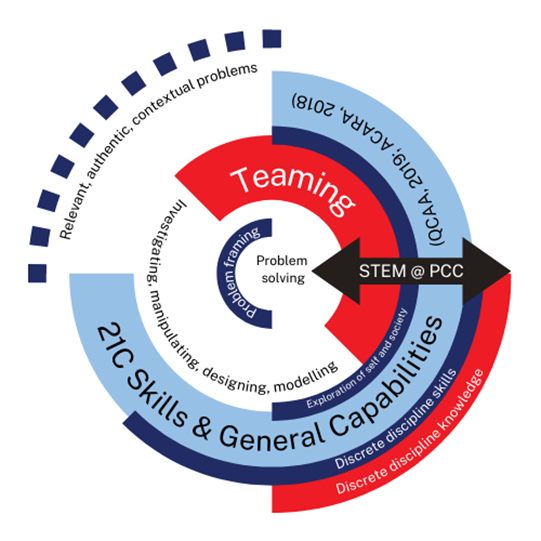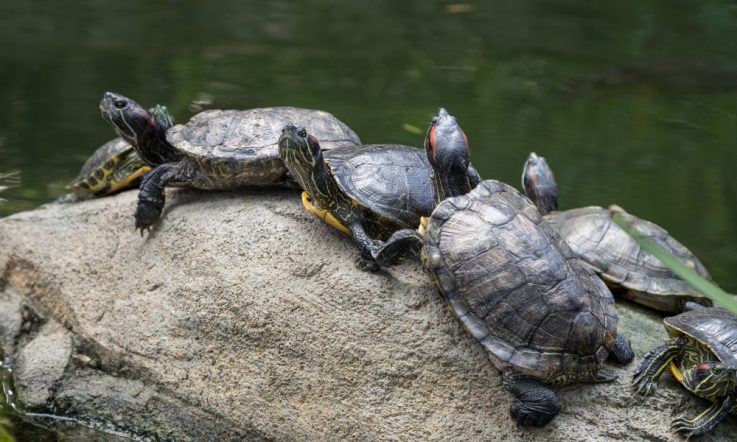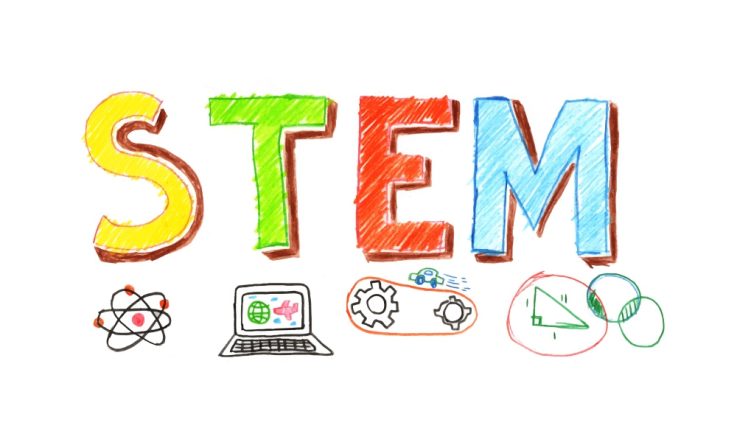In 2018, Kristie Schulz – Head of Curriculum (Secondary) at Parklands Christian College – wrote 3 articles for Teacher sharing how the Queensland school had successfully introduced a new STEM Studies elective for its year 10 students. The series explained how the journey began, the course design and implementation process, and approach to student assessment. Five years on, in 2 updates, she shares details of research findings looking at the pedagogical framework used and how the program has since been implemented in 3 prep classes.
The following article describes a 7-year exploration of STEM education, and what it could possibly represent in this contemporary, disruptive period of educational change. The story exists because a team of courageous and passionate educators noticed an opportunity and took a risk, in an environment where all too common barriers such as teacher workload intensity and fear of failure could have easily quashed hope.
Over the past 7 years, the STEM team at Parklands Christian College (PCC) have been working in a space that has felt formidable in every possible way with barriers and stereotypes that needed challenging at every turn in the road. Our journey in the STEM education space has been an important one, not necessarily because of the many stories of growth and achievement that we could be sharing, but because of the profound questions about education that it has raised for us.
We share our story in an attempt to light a fire in you, as first happened to us all those years ago, as a case study for how educational change is possible. We would like to present an alternative perspective of what STEM has come to mean to us at PCC, and how we believe the opportunity found in the STEM education space could be at the forefront of educational change, within a bounded system that we know isn't built for everyone.
Research partnership project
Since 2019 we have been studying our enactment process through a rigorous academic research project, in partnership with James Cook University. The research was framed as a descriptive, instrumental case study of transdisciplinary STEM education, enacted in the Queensland context. A key finding of the research has been the pedagogical framework that we utilise within the program.
STEM education, we have come to realise through the enactment process, presents us with an incredibly rare opportunity. As we suggested in our 2018 articles, policy documentation lacks agreed, definitional clarity of what STEM education is – in fact, presents a multitude of definitions. We know from policy that STEM education is regarded as an important factor within the education of young Australians, as we look to prepare them for an uncertain, unknown future. Add to this a lack of clear or specific implementation advice and many schools and teachers, like us, can be understandably confused about ‘how to do STEM well’.
Policy language and professional rhetoric was telling us that STEM is critical to the future of our nation, however, it was very difficult to find much information about how or when or with whom. It felt like an imperative without prescription, and we realised this doesn’t happen very often in our system. Through our enactment process, and the questions it has subsequently raised for us, we have realised the grey area we found ourselves in was a rare, golden opportunity. The intention of our program is to honour both the opportunity and the imperative with a transdisciplinary pedagogical framework and holistic interpretation of STEM education.
A pedagogical framework for STEM education
STEM at PCC takes the form of a year 9 elective subject with students attending 3 lessons per week. Through our 4-year research project, the transdisciplinary pedagogical framework utilised within the STEM classroom has been distilled into the following diagram.
Figure 1: The transdisciplinary pedagogical framework for STEM education utilised at Parklands Christian College.

Figure 1 shows the spiralled, layered approach that we take to STEM education. It is designed to be read from the outermost layers first, circling inwards as aspects of the framework, in increasing complexities, are drawn into the process. The first layers represent the discrete discipline-based knowledge and skills taught outside the STEM Studies classroom. Importantly at Parklands, students are explicitly taught and assessed in all Australian Curriculum content descriptors and skills within their Science, Mathematics, and Technologies classes, and not in the STEM classroom. This leaves time in the STEM class for using these skills and knowledge within the context of a student-identified problem, rather than explicit and direct teaching of content.
These problems (represented by small boxes on the outside of the diagram) also begin outside of the STEM classroom but are quickly drawn in as students seek them out through their lived experiences and learnings. Importantly, the problems students attempt to address are relevant, authentic and contextual to them as 14- to 15-year-olds. For example, we don’t ask them to design earthquake resistant buildings – society has professional engineers to do that (and they learn about it in their Science studies).
Instead, we ask them to find and address problems that are meaningful and important to their stage of life, where their perspective can have the most impact on the world. Over the years, students have created incredible projects such as developing video games to get young children involved in assisted citizen science projects, an app that helped visitors to our 46-acre site navigate to where they need to go, face masks that don’t smudge makeup and bumper guards for scooters to stop bruised ankles that often occur during briflips and rainbow kicks. Students are often given a brief – such as a specific timeframe, using specific resources or finding a problem within a relevant context. However, they always have voice and agency in all solutions, as teachers act as facilitators of knowledge, skills and networks that they may need.
Teachers then build structure to the course using ACARA’s General Capabilities, and create briefs, challenges and an environment for innovation using QCAA’s 21st Century Skills. Importantly here, teachers do not explicitly direct the problem that student are to address for the period of the project, this is an important step for students to do for themselves. For example, in one of our units called ‘The Teacher Project’, the teacher acts as the manager of a project, and asks the whole class to work together in one broad team. After a collaborative, diplomatic process of seeking and framing a problem they would like to address as a whole class, students apply for positions within sub-teams, such as ‘Research and Development’, ‘Communications’ or ‘Prototyping’ team.
This project highlights students’ strengths as they work in teams that suit their skills, but also develops a wide range of interpersonal skills as they find ways to develop a solution within a large group. They work collaboratively within and between their sub-teams to design and enact the solution. To do this, students must have self-awareness of their strengths and challenges within the classroom, and be able to rely on one another.
Exploration of self and society, as well as teaming, form critical parts of the STEM program at Parklands. To successfully work in a challenging environment, students must have metacognition of who they are and how they find success in their work, as well as an awareness of the other students in the class. We do some explicit work in this area using a range of tools such as MBTI, Belbin Team Roles, Working Genius and SuperPower card decks.
An example where these aspects of the pedagogical framework are put under the spotlight is within the ‘Two Week Project’. At the beginning of the project, students are asked to form teams. They are given autonomy about both the size of the teams and how to select teams. These teams stay in place for a 2-week period, after which they are disbanded and then reformed. Through each 2-week period across the term, teams focus on a different part of the project timeline – such as data collection or solution implementation. Importantly, there must only be one solution that all students and teams agree upon to implement. The student-centred nature of the classroom means this project will look different every year, as issues arise with the way aspects of the project are completed, or negotiation and mediation of disagreements about the solution. Often these projects are school-based, to enable easy access to data collection methods. Previous examples of a Two Week Project include: designing routing solutions to address construction sites being placed in key walkway junctions, and resolving issues with a siphoning effect and subsequent spilling of tea that was occurring with a particular brand of teabag that was available to staff in the staffroom.
Once a project is established, students utilise iterative cycles of investigation, modelling, problem-framing and finally problem-solving. This will look different in each project, as students establish and direct their problems to solve, and teachers utilise a responsive pedagogy to engage with student needs. Critical to the PCC STEM enactment process is the black, multidirectional arrow seen within Figure 1, which signifies that at any point in the spiral, the process can change direction, regress, jump ahead or revisit a layer.
The golden opportunity we noticed in the grey area of STEM education policy has afforded both students and teachers the chance to experience an optimistic and emboldened learning environment. We would love to connect with other educators, to share the stories of our students’ growth, frustrations, breakthroughs, barriers, challenges and success.
Our research suggests that we have created a dedicated and precious space in which our students can build the future-tolerant, human-centred skills and mindsets that will help them experiences successes, no matter where they find themselves.
Please reach out to us at kschulz@parklands.qld.edu.au – we are very happy to share any of our resources and the full research findings. We want to assist more schools to take advantage of the golden opportunity and experience the case for a courageous evolution of educational philosophy that is possible within the bounds of our system.
Stay tuned: Next week Kristie Shulz will be sharing details on how the program has been implemented in 3 prep classes.
At Parklands Christian College, students are tasked with finding and addressing problems that are meaningful and important to their stage of life, where their perspective can have the most impact on the world.
As a teacher, how do you ensure that the STEM tasks you assign students are meaningful and have application in the real world? What impact does this have on their enthusiasm towards the task?
Do you use this as an opportunity for students to work collaboratively and build on their interpersonal skills? What impact does this have on their overall engagement?



